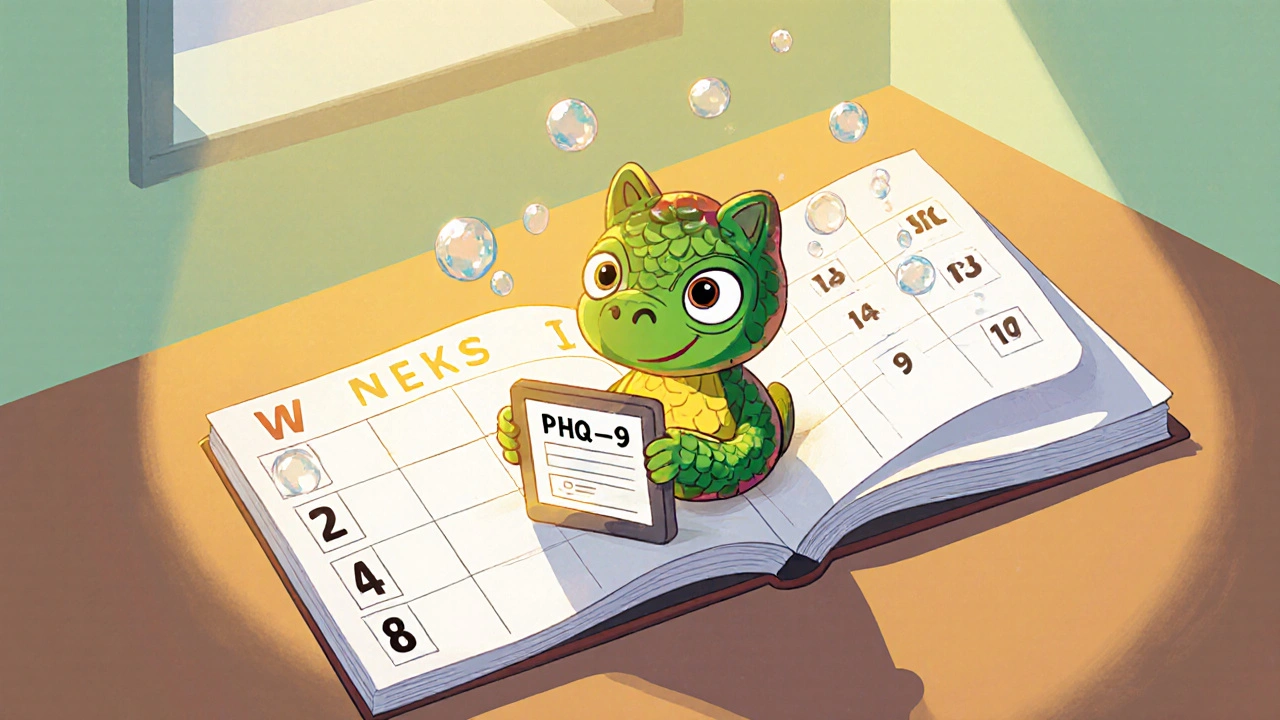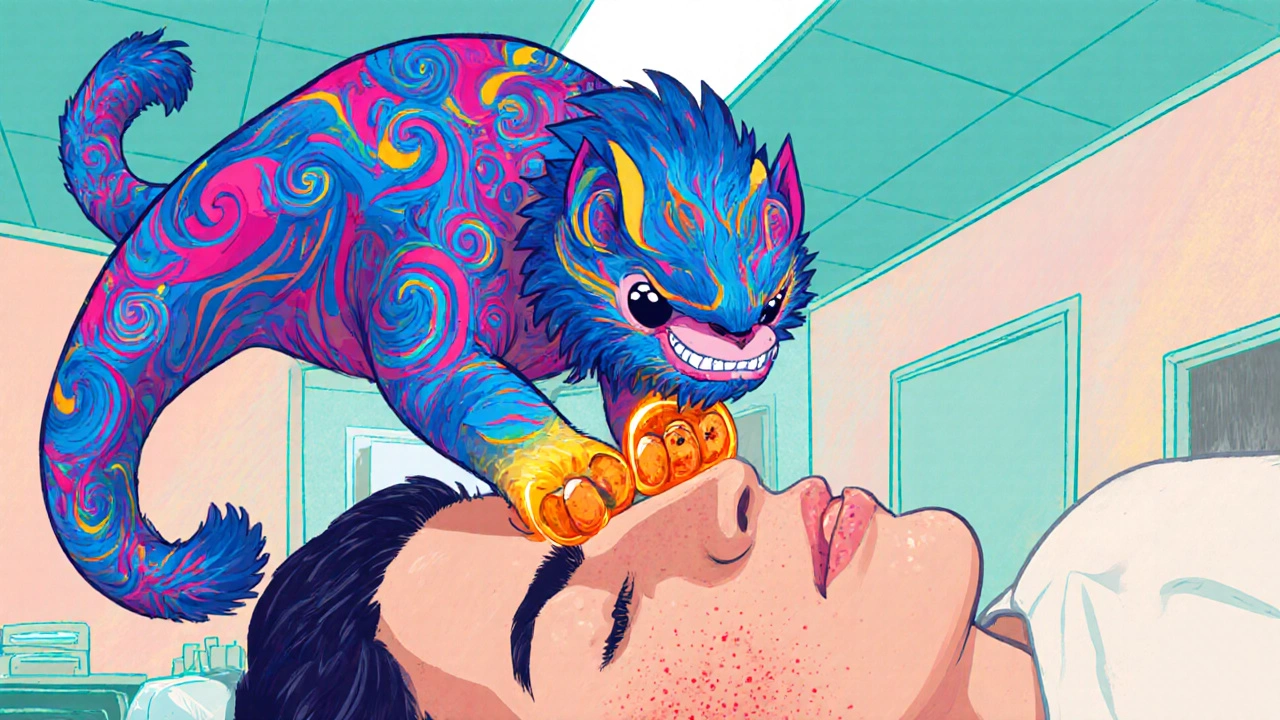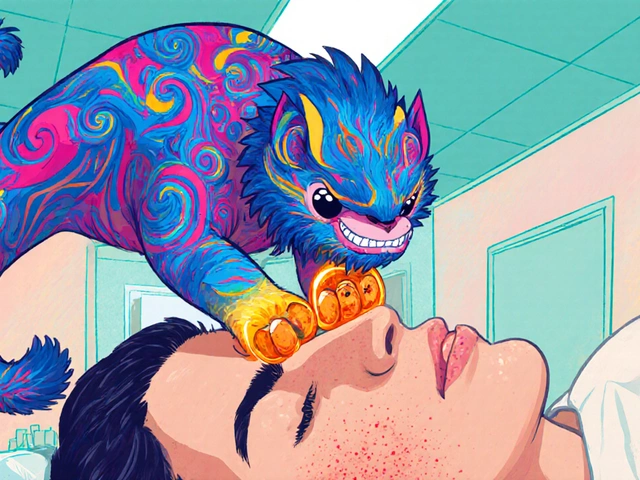When doctors treat severe acne, Isotretinoin is a powerful oral retinoid that reduces oil production and shrinks sebaceous glands. It’s praised for clearing stubborn nodular acne, but the drug also carries a black‑box warning for birth defects and a hotly debated association with mood changes. If you or someone you know is starting a course, knowing how to watch for depression can make the difference between a smooth skin journey and a mental‑health crisis.
What Is Isotretinoin and How It Works?
The medication was approved by the FDA in 1982 under the brand name Accutane and is now sold as several generics (Amnesteem, Claravis, Sotret) and the brand Roaccutane in Europe. Typical dosing ranges from 0.5 to 1.0 mg per kilogram of body weight per day for 15-20 weeks. By binding to retinoic‑acid receptors, it normalizes keratinization, cuts down sebum output, and reduces the size of oil‑producing glands. That triple action explains why about 85 % of patients achieve long‑term clearance after one course, according to a 2018 JAAD study.
The Controversial Link to Depression
Since the early 2000s, patients and clinicians have reported mood swings, anxiety, and even suicidal thoughts while on isotretinoin. The FDA’s Adverse Event Reporting System (FAERS) flagged depression in 47.5 % of psychiatric reports tied to the drug, with a reporting odds ratio of 3.30 versus non‑users. On the other hand, a 2023 meta‑analysis in JAMA Dermatology, covering more than 1.6 million people, found the absolute one‑year risk of a suicide attempt at just 0.14 %-lower than the 0.84-1.3 % seen in the general adolescent population.
So why the split? The FAERS data pool focuses on voluntarily reported events, which tend to over‑represent severe cases. Large‑scale epidemiology, however, dilutes those spikes by including everyone who never experiences mood changes. The truth sits in the middle: most patients face a low absolute risk, but certain subgroups-those with prior psychiatric diagnoses, younger age, or high baseline anxiety-appear more vulnerable.
What the Latest Data Say
Two recent studies illustrate the nuance:
- FAERS analysis (2025): 19,412 psychiatric events reported; depression accounted for 47.5 % and suicidal ideation for 17.7 %. The median time‑to‑onset was ~80 days, with 44 % of events occurring in the first eight weeks.
- JAMA Dermatology meta‑analysis (2023): pooled 1‑year depression risk of 3.83 %-roughly the same as the general teen population. Higher cumulative isotretinoin doses actually correlated with a modestly lower suicide‑attempt risk.
Both studies agree on one actionable point: the first two months are the critical window for monitoring.

Regulatory Guidance and Monitoring Requirements
The U.S. iPLEDGE program, updated in 2020 and again in 2025, now mandates monthly depression screening with the Patient Health Questionnaire‑9 (PHQ‑9). A score of 10 or above triggers a mandatory psychiatric referral. The American Academy of Dermatology’s 2022 consensus guidelines echo this, recommending a baseline psychiatric interview, monthly PHQ‑9 checks, and more frequent check‑ins during weeks 1-8.
Across the Atlantic, the European Medicines Agency (EMA) and Australia’s Therapeutic Goods Administration (TGA) have issued similar warnings. In July 2023 the EMA added a “differential‑diagnosis protocol” that requires clinicians to rule out vitamin B12 deficiency-present in about 18.7 % of isotretinoin users-before blaming the drug for mood changes.
Practical Steps for Clinicians
- Baseline Assessment: Document personal and family psychiatric history, current medications, and any prior mood disorders. Use the PHQ‑9 or Beck Depression Inventory (BDI) as a starting point.
- Set a Monitoring Schedule:
- Weeks 1‑8: weekly brief check‑ins (phone or secure portal).
- Weeks 9‑16: bi‑weekly updates.
- Beyond week 16: monthly until the course ends.
- Red‑Flag Protocol: Any mention of suicidal thoughts, sudden severe anxiety, or drastic mood swings warrants immediate discontinuation and urgent psychiatric evaluation.
- Mid‑Course “Mental‑Health Pause”: At week 8, schedule an in‑person evaluation before continuing. This aligns with UCSF’s protocol and captures the peak risk period.
- Document Everything: Use the iPLEDGE portal to log PHQ‑9 scores, counseling notes, and any referrals. The 2025 FDA update makes these records essential for program compliance.
Monitoring Tools Compared
| Tool | Length | Scoring Threshold for Referral | Pros | Cons |
|---|---|---|---|---|
| PHQ‑9 | 9 items | Score ≥10 | Validated, quick, integrates with iPLEDGE | May miss atypical symptoms |
| Beck Depression Inventory (BDI) | 21 items | Score ≥14 | More granularity, good for research | Longer, less common in dermatology clinics |
| HADS (Hospital Anxiety & Depression Scale) | 14 items | Depression subscale ≥8 | Captures anxiety as well | Less familiar to primary‑care providers |
Most dermatology offices adopt the PHQ‑9 because it fits neatly into the iPLEDGE workflow and can be administered electronically. If a patient already has a baseline BDI from a mental‑health provider, that score can serve as a supplemental reference.

Patient‑Centric Tips
- Know the Timeline: Expect mood shifts-if any-to appear within 2-3 months. Early weeks are the most volatile.
- Track Daily Feelings: A simple journal or a phone app that prompts a daily mood rating can catch subtle changes before they become severe.
- Maintain Support Networks: Encourage patients to share their mood scores with a trusted friend or family member.
- Don’t Stop Suddenly Without Guidance: If depression emerges, tapering off isotretinoin under medical supervision is safer than an abrupt halt.
- Consider Underlying Deficiencies: Vitamin B12, zinc, and omega‑3 levels are often low in severe acne patients and can influence mood.
When to Stop Treatment
Immediate discontinuation is warranted if any of the following occurs:
- Active suicidal ideation or plan.
- Severe depressive episode (PHQ‑9 ≥20) that does not improve within 48 hours of intervention.
- New onset psychosis, mania, or bipolar‑type symptoms.
- Uncontrolled anxiety unresponsive to supportive counseling.
In less urgent cases-such as mild to moderate depression with a PHQ‑9 of 12-14-co‑managing with a mental‑health professional while continuing isotretinoin may be appropriate, especially if the acne’s psychosocial impact is severe.
Key Takeaways
Isotretinoin remains one of the most effective acne solutions, but its psychiatric safety profile requires careful, structured monitoring. The combination of a baseline psychiatric screen, weekly check‑ins during the first eight weeks, and the use of standardized tools like the PHQ‑9 can catch most clinically relevant mood changes. Clinicians should stay alert to red flags, document everything in the iPLEDGE system, and involve mental‑health specialists early when needed. For patients, understanding the timeline, keeping a daily mood log, and having a trusted support person are simple steps that dramatically reduce risk.
How soon after starting isotretinoin can depression appear?
Most mood changes show up within the first 8 weeks, with a median onset around 80 days. That’s why weekly monitoring during this window is recommended.
Is there a dose‑dependent risk for depression?
Surprisingly, higher cumulative doses have been linked to a slightly lower suicide‑attempt risk in large studies, possibly because patients who tolerate higher doses tolerate the drug better overall.
Can vitamin B12 deficiency mimic depression on isotretinoin?
Yes. About 19 % of isotretinoin users develop low B12, which can cause fatigue and low mood. Testing and supplementing can rule out this reversible cause before blaming the medication.
What genetic marker might predict depression risk?
Preliminary research points to the BDNF Val66Met polymorphism. In a pilot study, it showed about 68 % sensitivity for isotretinoin‑related depression, but it’s not yet a clinical test.
Should I stop isotretinoin if I have a history of anxiety?
A prior anxiety disorder doesn’t automatically rule out isotretinoin, but it does mean you need tighter monitoring-weekly PHQ‑9, possibly a baseline BDI, and a clear plan for rapid psychiatric referral if scores rise.


Honestly, the hype around isotretinoin’s mood side‑effects is just another excuse for people to avoid responsibility for their own skin care choices.
Whoa, it’s like stepping into a rollercoaster of confidence and chaos-your skin clears, but the emotional rides can be wild!
Indeed; the pharmacodynamics are well‑documented, yet the anecdotal narratives often - over‑sensationalized!!! We must remain vigilant, but also rational.
Dear community, I appreciate the thorough overview; the structured monitoring schedule is commendable 😊. Please ensure patients receive clear instructions and compassionate follow‑up.
From a dermato‑pharmaco perspective, the PK/PD window of isotretinoin aligns with the hypothalamic‑pituitary‑adrenal axis modulation-so you’re basically juggling dose‑dependent neuro‑chemistry alongside sebaceous suppression.
That’s spot on; the interplay is complex. In practice, a clear weekly check‑in can demystify the process for patients while clinicians stay on top of any subtle shifts.
Listen up, folks! This isn’t some foreign “trend”-it’s US‑made science, and we’re not letting anyone sow panic over a life‑changing drug!!! 💥💥💥
While the passion is noted it is essential to recognize that clinical data does not support blanket alarm the risk of depression remains statistically modest and monitoring protocols are designed to mitigate any potential adverse psychological outcomes
Sounds like a lot of paperwork.
Hey! I get that it looks overwhelming :) but the PHQ‑9 is super quick and can really help catch issues early. Let’s take it step by step!
Oh, wonderful, another glorified prescription pamphlet masquerading as a medical breakthrough, as if popping a handful of pills will magically solve teenage angst and existential dread. The authors parade statistics like holy writ, yet they conveniently gloss over the fact that millions of teens already grapple with self‑esteem issues without needing a drug that can potentially cloud their minds. One would think that clinicians would prioritize holistic care over a glossy “clear‑skin” marketing campaign. Instead, we get endless tables of PHQ‑9 thresholds, as if a number can replace genuine human connection. The emphasis on weekly check‑ins sounds caring, but in reality it becomes a bureaucratic tick‑box exercise that breeds resentment. And let’s not forget the absurdity of blaming vitamin B12 deficiency for mood swings-what a convenient scapegoat! Patients are left wondering whether their depression is a side effect, a deficiency, or simply “bad luck.” The moral of the story? If you’re willing to subject yourself to a drug with a black‑box warning, you should also be willing to swallow the endless paperwork that follows. Meanwhile, the pharmaceutical industry watches profit margins soar while we wrestle with the ethical implications. So, congratulations on the thorough guidelines; now excuse me while I draft an op‑ed about the commodification of mental health. In the end, perhaps the real risk isn’t the drug itself, but our collective complacency. Let’s hope future research actually addresses the root causes instead of shuffling more forms onto our desks. Until then, keep those PHQ‑9 scores coming, dear clinicians, and enjoy the endless cycle of monitoring. 🙃